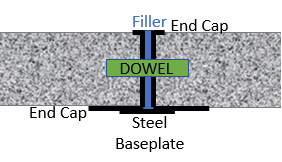BACKGROUND
Concrete pavements, including roads, parking lots, and industrial pavements, are critical to transportation and economic function. Joints are cut into the pavements, allowing for temperature-driven contraction and expansion to prevent further damage. Unfortunately, due in part to elimination of expansion joints and the preference of low-shrinkage concrete, compression failures known as blowups, buckling, or tenting continue to occur. Traditional expansion joints have been broadly eliminated in new pavement construction due to their historically poor performance. Blowups occur in hot weather when pavements attempt to expand and are restrained, resulting in them buckling upward. This type of damage poses a danger to vehicles and pedestrians alike, resulting in injuries as well as down time of the pavement’s use as expensive repairs take place, draining responder resources and infrastructure funding. Given the increasing frequency of intense heat waves and higher peak temperatures capable of inducing blowups with pavement configurations, there is a clear and present need for improvements in concrete pavement joint performance.
SUMMARY OF TECHNOLOGY
Researchers at OSU are developing a modular concrete pavement expansion joint (MPE) to allow concrete pavements to expand in hot weather without damaging the pavement. The system utilizes a steel base plate, dowels, and steel slab uneven-end caps. The MPE has several potential areas of application, such as joints between pavements and bridges, new concrete pavement construction, repairing joint blowups as well as retrofitting to existing pavements to prevent blowups. In the use of bridge-pavement joints, this also creates a smooth transition which current joints largely lack. Employing the MPE in the construction of concrete pavements will generate revenue savings by preventing expensive repair situations in new construction or retrofitting to at-risk areas, as well as allowing for more efficient spending of infrastructure funding.

POTENTIAL AREAS OF APPLICATION
- Jointed highway pavements
- Joints between concrete pavements and bridges
- Parking lots and industrial pavements
- Repair of joint blowups
- Retrofit to existing pavements
MAIN ADVANTAGES
- Prevents pavement blowup
- Provides smooth, long-lasting connections
- Ease of use
- Creates safer pavements
STAGE OF DEVELOPMENT